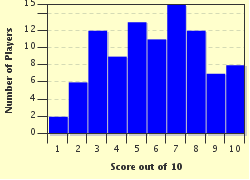Quiz Answer Key and Fun Facts
1. The 1916 silent version of "Romeo and Juliet" starred Francis X. Bushman and Beverly Bayne. Who gave voice to the young lovers in Franco Zeffirelli's 1968 version of Shakespeare's play?
2. Would Tarzan still have been himself without his famous yell? Before Johnny Weissmuller made the distinctive cry famous in "Tarzan the Ape Man" (1932) and subsequent movies, another actor mimed yelling in 1918's "Tarzan of the Apes". Who was that actor?
3. The 1962 sound remake of "The Cabinet of Dr Caligari" (1920) made some changes from the original German horror classic, including dropping "doctor" from the title. The original included a creepy character named Cesare, portrayed by which German actor? (He later played a Nazi in "Casablanca".)
4. Both the 1921 silent and 1962 sound versions of "The Four Horsemen of the Apocalypse" told a sprawling tale of an Argentinian family with ties by marriage to both France and Germany. The later movie updated the action from WWI to WWII, but the essential conflict remained between the two branches of the family. The French grandson was played in the silent version by Rudolph Valentino. Which Canadian-born actor played the same role in 1962?
5. The director of the silent "The Ten Commandments" (1923) liked the story so much that he directed the 1956 sound version as well. Who was that director?
6. In the silent version made in 1923 Lon Chaney played him; Charles Laughton took the role in the 1939 sound movie; Tom Hulce voiced him in a 1996 animated version. Who was this character, whose alternate name provided the title of these films?
7. The title role in the silent and sound versions of "Ben-Hur" was played by Ramon Navarro in 1925 and Charlton Heston in 1959. Which two actors played his childhood friend turned adversary, Messala?
8. Lon Chaney made the title role his own in the 1925 silent "The Phantom of the Opera", a fact which did not stop later film makers from giving the role to other actors. Who gave his own interpretation in the 2004 movie adaptation of Andrew Lloyd Webber's musical version of the story?
9. The comedy-drama "What Price Glory?" was made as a silent in 1926 and remade with sound and music in 1952. During which war was this tale of a couple of US Marines and their romantic and military escapades set?
10. In both the 1926 silent movie and the 1939 sound remake of "Beau Geste", why did Beau join the French Foreign Legion?
Source: Author
spanishliz
This quiz was reviewed by FunTrivia editor
jmorrow before going online.
Any errors found in FunTrivia content are routinely corrected through our feedback system.

